Search Engine Optimization (SEO) can be one the most powerful ways to generate traffic for your e-commerce store.
When you know how to hit the first page of Google for certain keywords, you'll be able to place your e-commerce store in front of people who are actively looking to spend money.
In this guide, we’re going to examine how you can achieve such results and make SEO work for your e-commerce store.
We’re going to review some of the basic aspects of ecommerce SEO, such as identifying the right keywords, as well as some of the more complex ideas such as site architecture.
By the end of this guide, you’ll know how to use SEO to boost the visibility and sales of your ecommerce site, in a way that is sustainable and effective.
Let’s begin.
Table of Contents
The Ecommerce SEO strategy
SEO strategy for online stores can become very complex if you let it.
But the best SEO strategies, are often the simplest ones.
Simple SEO strategies often work well, because they pay attention to the main factors that Google uses when ranking websites.
In basic terms, there are two key factors Google will review when it ranks a page within its search results:
- How relevant a page is, in relation a certain search term. Though there is a lot else that goes into it, Relevance is often defined by the keywords used within that page as well as how detailed that page is.
- How many links are pointing to the page in question – more specifically, how many links exist on other websites, of which use words related to the keyword that has been typed in.
Yes, SEO can be a lot more complex than the explanation provided above.
But in this post, we’re going to keep things as simple as possible.
In doing so, it will be easier for you to grasp the general concept of SEO — speeding up the time it will take for you to generate results.
So… In line with what we’ve just discussed, the SEO strategy we’re going to cover in this guide will work be based on the following framework –
- Identify keyword opportunities
- Attempt to rank for our chosen keywords using in depth (ideally evergreen) content. The detail of this content will make it seem relevant in the eyes of Google and attract a lot of links in the process, because it will become a trusted resource.
- Perform general ‘On Page SEO’ which takes care of some of the technical aspects of SEO.
That’s it.
If you create good content, Google will naturally help you improve your rankings as it will deem your content to be the most relevant for certain keywords. Plus, your content will naturally attract more links – thereby helping you take care of the ‘link building’ side of SEO.
While you could add a few more bits to the process, the above strategy should be more than enough to get you some quick but sustainable wins that will help your ecommerce store.
The different types of keywords
Before we dive into the nitty gritty of identifying the keywords you need to target, there is something you need to understand about the nature of the keywords that people are typing into Google.
Different keywords represent different forms of intent.
If you don’t understand intent, you’ll end up developing an SEO strategy which might produce a lot of traffic – but little profit.
In simple terms, there are two kinds of intent when it comes to your keywords:
- Informational keywords
- Buyer/Commercial Keywords
Keyword intent is often signaled by the other words that people will use alongside the base keyword in a search string.
As you might’ve guessed, ‘buyer’ keywords are keywords typed in by people who are actively looking to buy something.
Such keywords tend to produce a lot of revenue for your store, if you rank highly for them.
Let’s suppose that we had an ecommerce store that was related to knitting.
An example of a buyer keyword in this niche would be:
- Buy knitting yarn
- Buy knitting needles
- Knitting yarn deals
- Cheap knitting yarn
- Purchase knitting yarn
As you can see, these keywords would be typed in by someone who is ready to, or is at the very least on the verge of, buying the items mentioned.
Because such keywords are profitable, they tend to attract a lot of attention from your competition.
This means that it’s not always easy to rank for buyer keywords, and sometimes the task can be outright impossible, or at the very least – take a lot of time.
Informational keywords, on the other hand, are generally typed in by people who are looking for information, in regards to a certain topic/product.
There’s less of a guarantee that the individuals typing in these keywords, are going to become customers.
However, such keywords do give you the chance to get in front of people, of whom you can later turn into customers.
No matter what niche you’re in, there are often much more informational keywords that there are buyer keywords.
You’ll also tend to find that informational keywords are easier to rank for.
Examples of informational keywords might include:
- How to knit
- Knitting tips
- How to knit clothes for a baby
- Knitting guide for beginners
On the whole, you’ll want to make sure that you have a good mix of both informational and buyer keywords.
This will ensure that you have an expansive SEO strategy that will help you gain some quick wins, whilst also setting you up for long term success.
Because the main focus of this post centers around creating content in order to improve your rankings, you’ll notice that we’re going to focus more on informational keywords, rather than buyer keywords.
Note: In some cases, there is also a third type of keyword, known as the ‘product’ keyword. Product keywords can be worth targeting because they’re often ignored by the competition.
You’ll tend to find that product keywords are a mix between informational keywords and buyer keywords.
They’re generally typed in by people who are on the verge of buying something, but just want to do some research first.
Such research might include finding the best version of something or perhaps just the cheapest.
On top of that, such keywords will give you the chance to set yourself apart from the competition.
Performing keyword research for your Ecommerce Store
In this guide, the tool we’re going to focus on using the Google Keyword Planner to perform keyword research.
Even though there are many other tools that you can use when it comes to keyword research – if you’re on a budget the Google Keyword Planner is best, because it is free.
When you begin to generate some revenue from your ecommerce store, though, you should definitely think about investing in solutions such as SERPed.net and others.
That’s because such tools make it easy for you to find opportunities, that would be hard to otherwise locate using the Google Keyword Planner.
Note: If you don’t have an account with Google AdWords, you’ll need to create one as you can’t use the Google Keyword tool without an AdWords account. So if you don’t have one, create one now, and then come back to this section of the guide.
Let’s take a look at how you can use the Google Keyword tool.
To begin with head over to https://adwords.google.com/home/tools/keyword-planner/.
You should then see this screen.
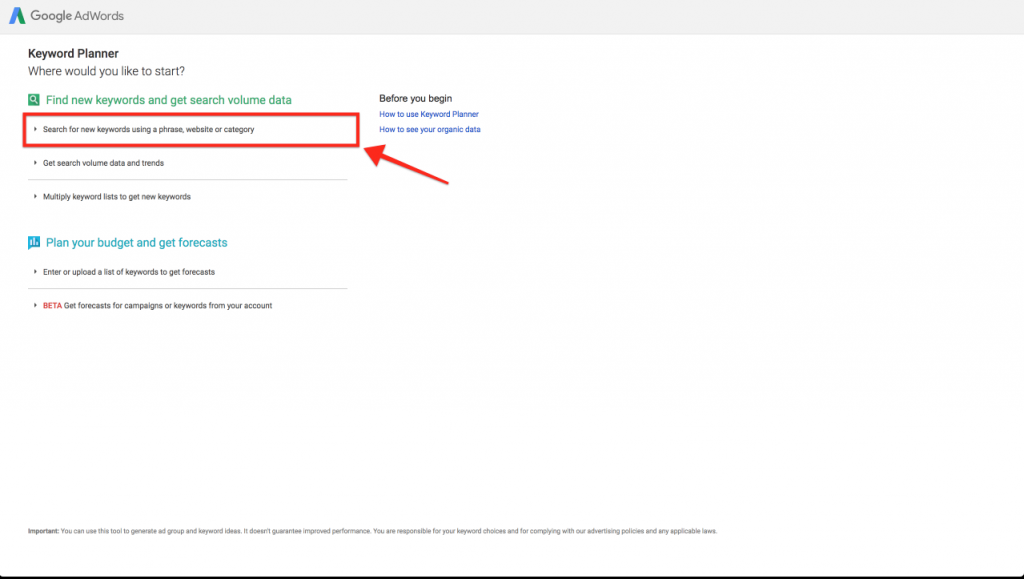
Click on ‘ Search for keywords using a phrase, website or category.’
You’ll then see the following ‘box’ open up.

In the ‘Your product or service’ dialog box, you need to type in a ‘base keyword.’
Don’t overcomplicate this base keyword, as your goal at the moment is to identify as many keyword opportunities as possible.
For the sake of this post, let’s suppose we’re crafting content for an ecommerce store that sells items related to ‘knitting.’
My base keyword, therefore is going to be ‘knitting.’
For now, leave the ‘Targeting,’ ‘Customize your search’ and ‘Date range’ sections as they are.
Then click on ‘Get Ideas.’
You should then see a screen like the one below.
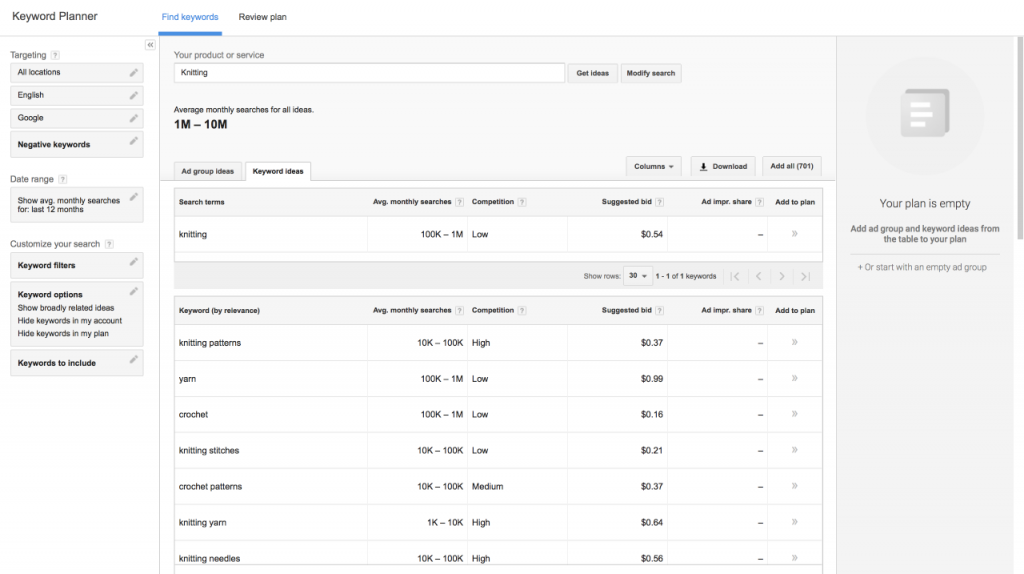
As shown above, there are around ‘1M-10M searches’ related to the term ‘knitting.’
This is good, because it lets us know that there is a demand for products and content related to knitting.
It’s also good, because it represents a lot of potential keywords (and therefore opportunities) I can go after.
This, therefore, limits the impact that existing competition will have on my ability to succeed with SEO in this niche.
Now, one thing you’ll notice on this page is that there are two tabs – ’Ad group ideas’ and ‘Keyword’ ideas.
The ‘Ad group ideas’ tab groups keywords together into topics, as shown below.
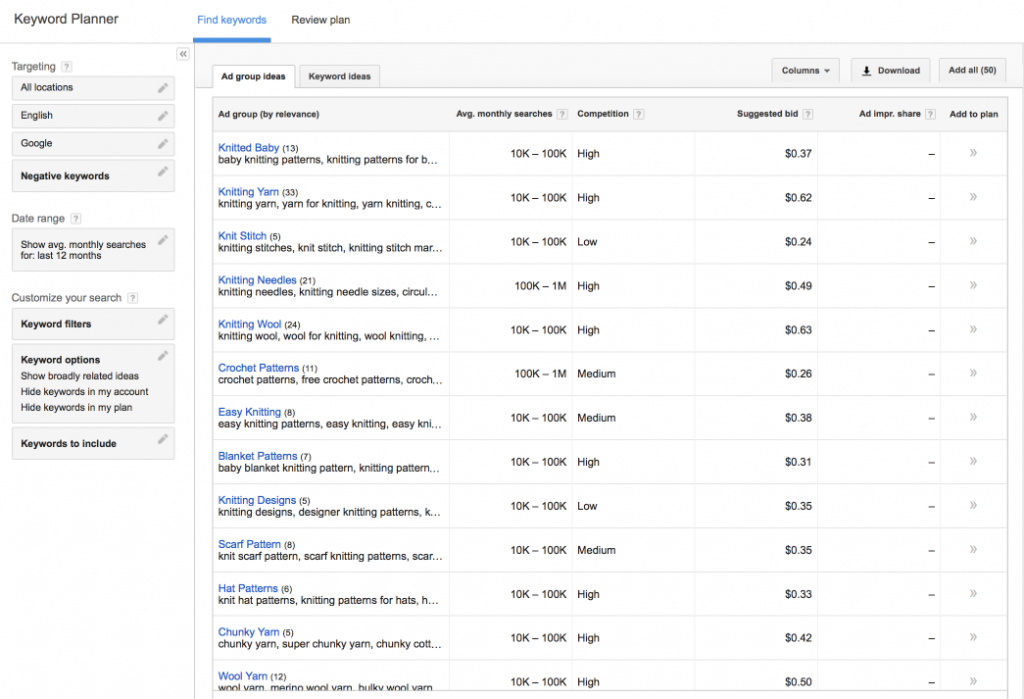
The ‘Keyword ideas’ tab, simply lists all of the keywords that the Keyword Planner has found, in relation to the ‘base’ keyword that was initially typed in, as shown below.
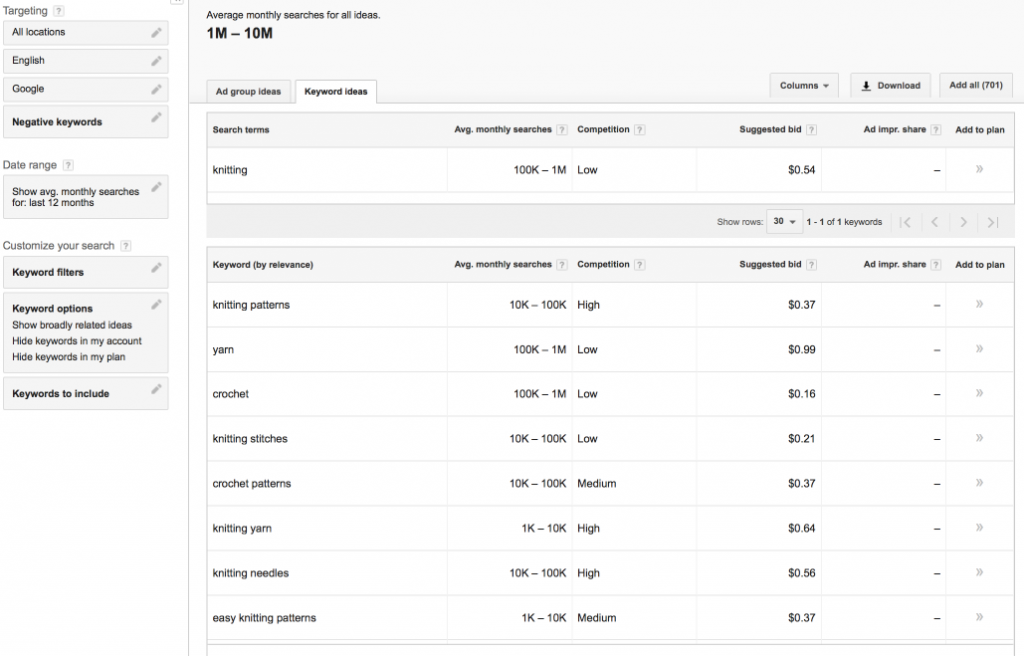
So what should you do now?
Well, before you do anything else, let’s quickly take a look at how you should analyze the data returned by the keyword tool.
More specifically how you should use the ‘Avg. monthly searches,’ ‘Competition’ and ‘Suggested bid’ columns, to inform your strategy.
The first thing you need to keep in mind, is that the ‘Competition’ and ‘Suggested bid’ columns provide data based in relation to AdWords.
The competition column lets you know how many advertisers are competing to bid for a certain term. The ‘Suggested bid’ column lets you know what advertisers are typically paying, for a specific keyword.
Now, whilst this data is designed to help people using AdWords, it can still be used for SEO.
Why?
If there is a keyword that has a high suggested bid, it’s often because there are people making money, by placing ads for that keyword.
The same applies to keywords that have a lot of competition – advertisers are competing for a reason.
All of this lets you know which keywords are going to drive profitable results for your ecommerce store.
If you can rank for these ‘high-value’ keywords, you’ll be able to get a ton of profitable traffic, that other companies are willing to pay a lot of money for.
Now, your natural inclination might be to go after the keywords that are driving the most traffic – AKA the keywords with the most ‘Avg. monthly searches.’
But a lot of the time, such keywords are often too broad to drive the kind of traffic to your site that will generate sales.
You’ll tend to find the more specific keywords, with lower search volumes, are the ones that tend to provide the best traffic.
Because of this, it’s always a good idea to pay attention to the Suggested Bid and Competition columns, when deciding on which keywords you should go after, rather than solely on the Avg. monthly searches column.
So with that in mind, let’s explore how we can discover keywords that will be worth incorporating into our SEO strategy.
Well, to begin let’s focus on the ‘Keywords tab’ and sort the keywords by suggested bid.
This will help us identify the keywords that will drive the most profitable traffic.
Here’s what happened when I sorted the keywords based on the suggested bid.
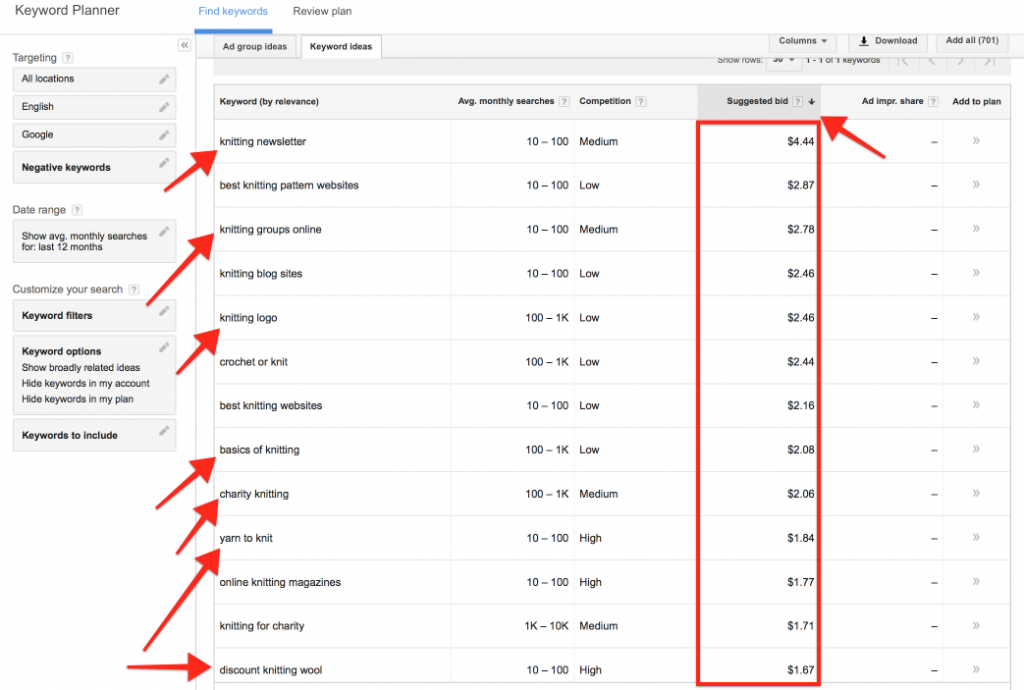
As you can see, the suggested bids for the keywords are quite high and there are individuals willing to pay as much as $4.44 for certain keywords.
This can seem surprising, especially since a lot of these keywords look as though they’re in the ‘informational’ category.
However, it just goes to show how powerful informational keywords can be, in terms of their ability to drive traffic that will eventually become profitable.
One thing you might notice with these keywords, is that the ‘Avg. monthly searches’ are quite low for some of them.
However, as mentioned earlier, because these keywords are likely to drive a lot of profitable traffic (as indicated by the fact that people are willing to pay a lot to target such keywords) the low keyword volume can be excused.
If you look at the screenshot, you’ll notice that I’ve drawn attention to some keywords that look as though they’ll be good keywords to rank for.
Aside from the research done here, the most basic way I can decide whether or not I should incorporate these keywords into my SEO strategy, is by searching for them on Google.
Upon typing these keywords into Google, all I need to do is check if there are any web pages that contain the keyword in their title tag, and/or cover the keyword topic in exceptional depth.
If there are pages that contain the keyword in their title tag, it shows that other websites are aware of the potential for this keyword.
However, if the content provided by these websites is ‘thin’ and the top ranking pages aren’t that in depth, then it represents a chance for you to create something more authoritative and in depth, and therefore rank higher.
Even if other websites are targeting this keyword, within their SEO strategy.
Similarly, if there is content that is in depth, but it doesn’t contain the keyword within the title tag, you have the chance to rank highly for that keyword.
Because it shows that other sites aren’t necessarily going after that keyword, within their SEO strategy.
Remember – Google wants to deliver a good user experience, and they can do this by providing content that is the most relevant.
If your content has a title that contains the keyword people are typing in, while also being more in depth than competing links for the same keyword – Google will naturally deem your content as being more relevant.
This, therefore, helps you rank high for the keyword you’re targeting, over time.
So, let’s explore this concept a little bit more by searching for one the keywords provided by the Google Keyword tool.
Let’s just pick the random example of ‘Yarn to knit.’
Now, there are a lot of ads for this keyword, showing that companies are making money of this keyword.

However, when we look at the search results, we’re not really presented with a definitive piece of content that contains this keyword in the title.

So this represents an opportunity.
Another way you can go through this process, is by sorting your keywords using ‘Competition’ instead of ‘Suggested bid.’
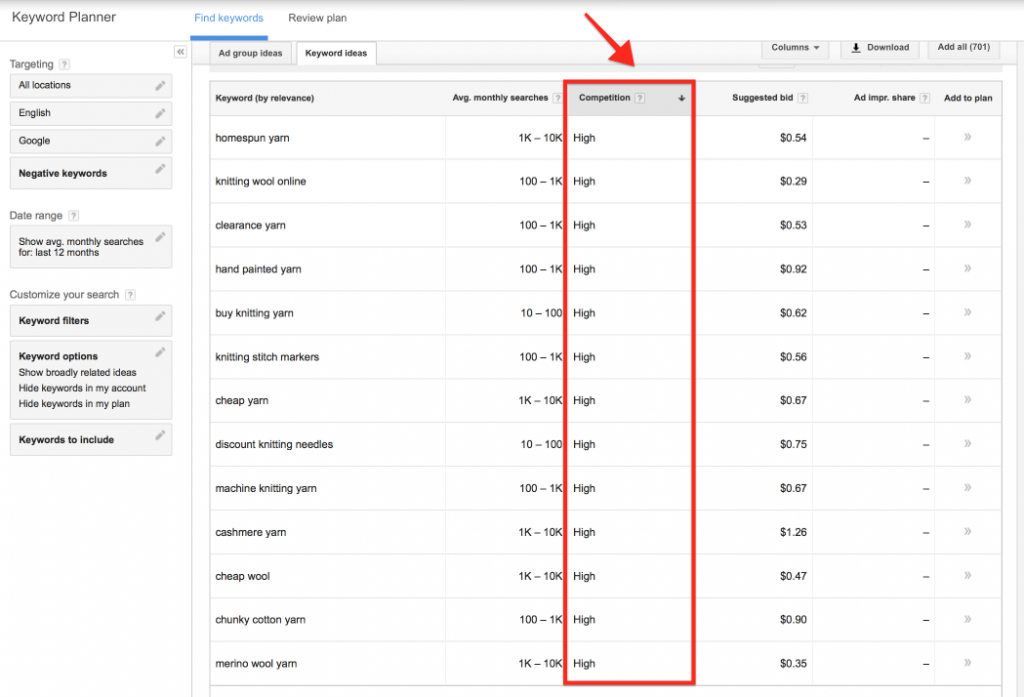
When you sort keywords by competition, you’ll tend to find that the keywords returned, often generate larger ‘Avg. monthly searches.’
Therefore if you’re in search of high-value keywords that still generate a lot of traffic, it’s always good to combine both keywords with a lot of competition as well as keywords with a high suggested bid.
If you’d like to find high-value keywords that competitors have ignored, consider selecting a keyword delivered initially by Google Keyword Planner, and then going through the process again, but with this existing keyword.
Doing this, can be a good way to find derivatives of a high-value keyword, that will be equally as effective at driving quality traffic, that your competitors might not be aware of them or ignoring them.
Let’s do this using the keyword, ‘basics of knitting’ – a keyword that was provided by the Google Keyword Planner when I initially just performed used the base keyword ‘knitting.’
If I type that keyword into the Google Keyword Planner, I’m presented with the following variations of keywords.
If I then sort these keywords, by suggested bid, in order to find the most profitable keywords, I’m then shown the following keywords.
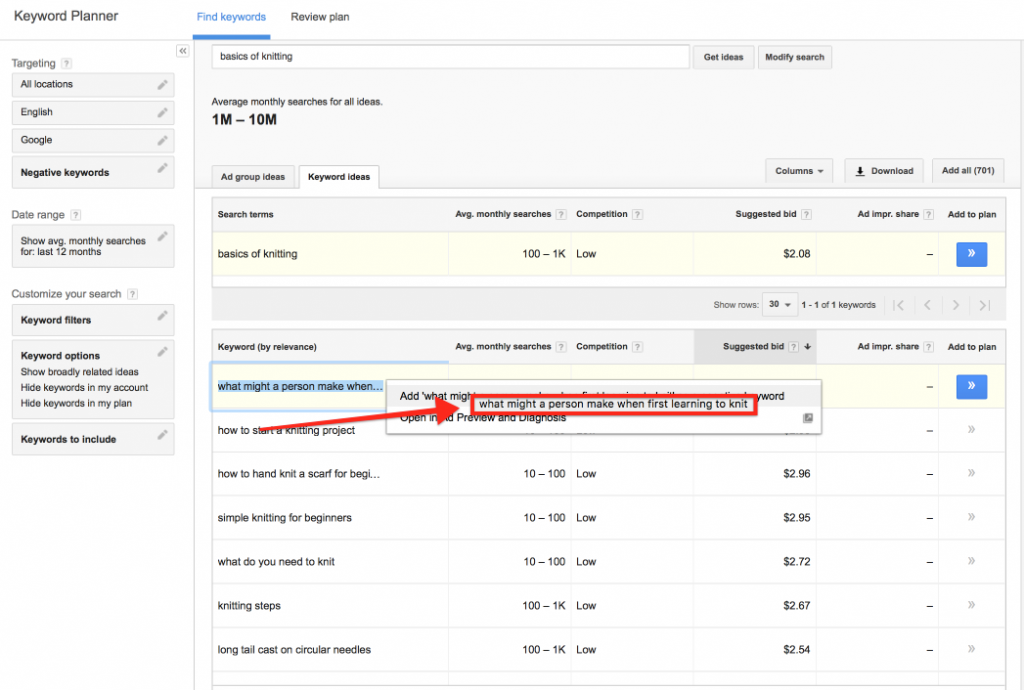
The first keyword shown, is ‘what might a person make when first learning to knit.’
Since this is a high-value keyword, it might be worth incorporating it into my strategy.
Plus, it would be relatively easy to create a piece of in depth content around this keyword, improving the odds of me being able to rank for it.
Let’s take a look at what crops up in Google when we type that keyword in.

After typing that keyword into Google, we can see that there are two links that use the exact phrase in their title.
However, both of these examples aren’t really examples of in depth content.
This provides me with an opportunity to potentially outrank them, if I put the time into to creating something better, of which also uses the exact keyword in the title.
Let’s also take a look at the keyword example of ‘how to start a knitting project’ to see how easy it would be to rank for it.
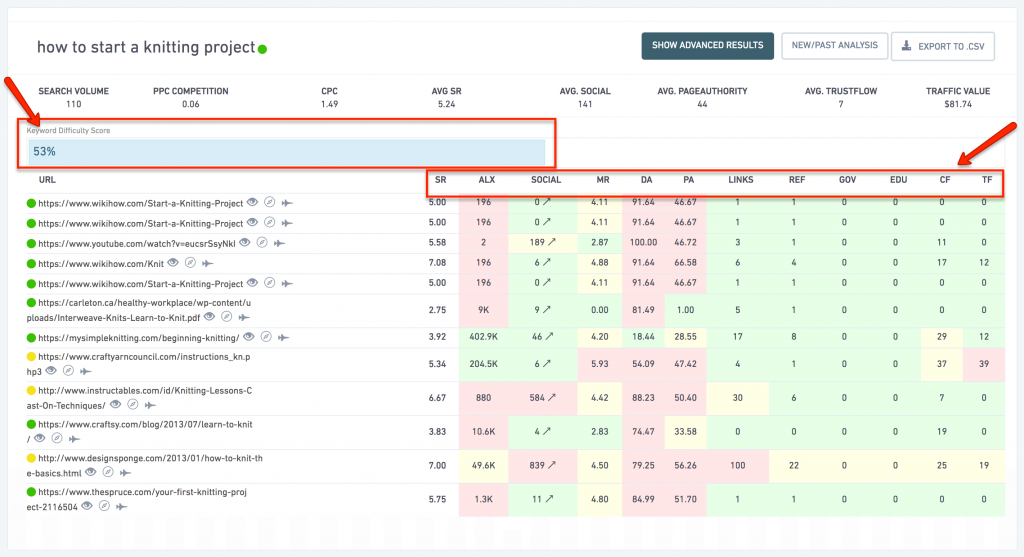
With a keyword difficulty score of 53%; the tool suggest it is not difficult to rank for this keyword.
Again, to re-confirm, let's type that keyword into Google.

Then, if I review the search listings, I can see that there isn’t really an in depth piece of content, that uses precisely this keyword in the title.

This, therefore, presents an opportunity to rank for a potentially high-value keyword, of which my competitors might have ignored.
As discussed earlier, there is also the option to sort keywords using ‘Competition.’
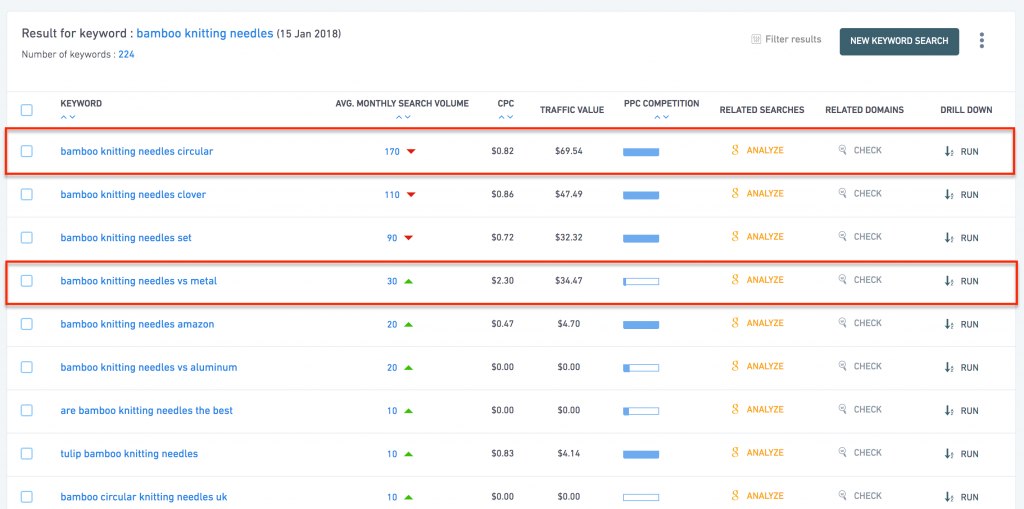
You should always seek out opportunities by sorting results by Average Monthly Search Volume as well as CPC.
CPC tends to show you high value keywords with low volume.
But Average Monthly Search Volume more often than not, shows you keywords that generate a lot of traffic, whilst also being profitable (though probably not as profitable as the keywords that have high suggested bids).
Above, I’ve highlighted the keyword ‘bamboo knitting needles’ of which has a lot of competition and generates a lot of (relatively) monthly searches.
If we type this keyword into Google, we’re then presented with the following results.

Here are the other links that can be found, when scrolling down the page.

A lot of these links point to online stores.
However, there isn’t really a piece of content that pops up in relation to this keyword.
Therefore, if we were to create an in depth piece of content, around the topic of ‘bamboo knitting needles’ we’d potentially do a good a job at ranking for this keyword.
For instance, we could create a piece of content such as a ‘buying guide for bamboo knitting needles.’
Note: Even if we didn’t want to rank specifically for the keyword ‘bamboo knitting needles’ – by creating an in depth piece of content around the topic of bamboo knitting needles, we’d still rank for other terms related to bamboo knitting needles. This is arguably still beneficial, and speaks to the power of something known as ‘long tail keywords.’
Long Tail Keywords
Long tail keywords are highly specific keywords that contain a lot of words. If you create a long form piece of content, you’ll naturally be able to rank for more long tail keywords.
Because the people typing in long tail keywords are being so specific, there’s often a good chance that such individuals will eventually become customers.
Traffic related to bamboo knitting needles is high quality, as signified by the fact that marketers are willing to pay to get themselves in front of people typing in the keyword ‘bamboo knitting needles.’
Therefore, if someone is typing in a keyword that is related to bamboo knitting needles, and they end up on your site (as a result of your content ranking for a ‘long tail keyword’) there’s a good chance that they’ll be the kind of person that might spend with your store.
If you want to find examples of long tail keywords, you can also make use of the ‘Autosuggest’ feature provided by the ‘Google search bar.’
If I type in the phrase ‘bamboo knitting needles’ I’m instantly presented with a keyword that represents a potential opportunity.

If I search for this keyword, I can see that there is no content or web page that accurately covers this keyword – presenting me with an opportunity.

While it can take a lot of effort to find such long tail opportunities, you’ll tend to find such keywords represent a lot of potential – that your competitors are probably ignoring. Let’s briefly also take a look at how you can use the ‘Ad Groups’ feature, within the Google Keyword Planner.
It should be your goal to adopt a comprehensive SEO strategy, that will help you cover a wide range of topics.
Going after a wide range of topics is important, because by doing so, you ensure that you’re expanding the reach of your store, as much as possible.
If you want to find out what these topics should be then the Ad Groups feature can be particularly helpful.
Let’s review what Ad Groups are shown to us, when we use the original keyword of ‘knitting.’
As shown below, a wide range of Ad Groups have been returned in relation to the keyword ‘knitting.’
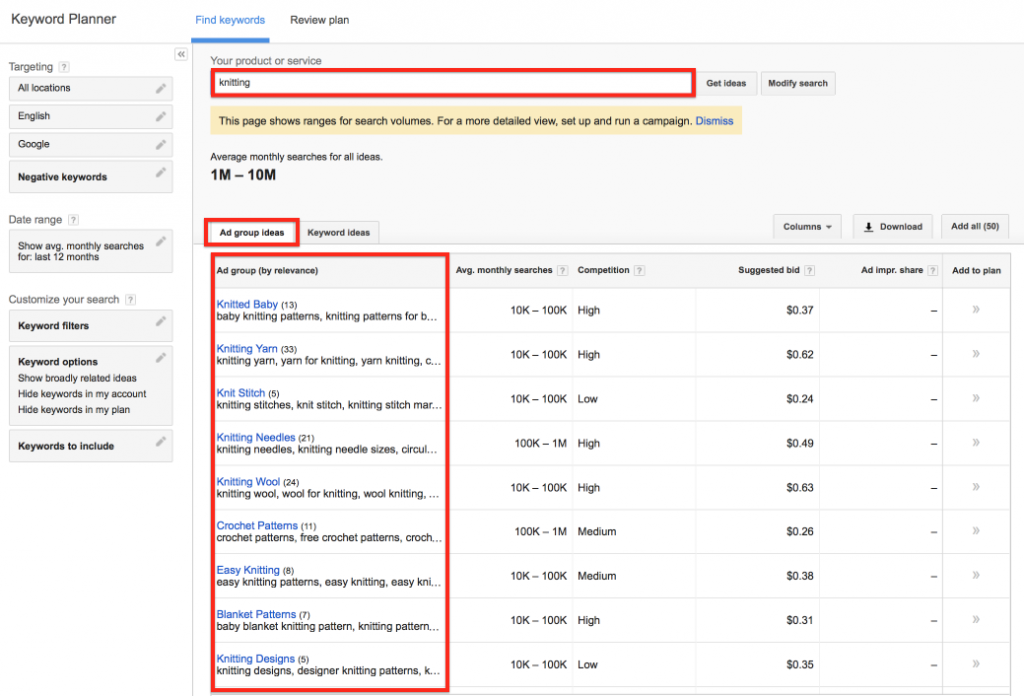
If we scroll down a bit more, we’re able to see even more Ad Groups, related to this keyword.

If we click on these Ad Groups, we are then shown a wide range of keywords, that represent the Ad Group (topic) in question.
For instance, here are the keywords that appear, when I type select the ‘knitted baby’ Ad Group.
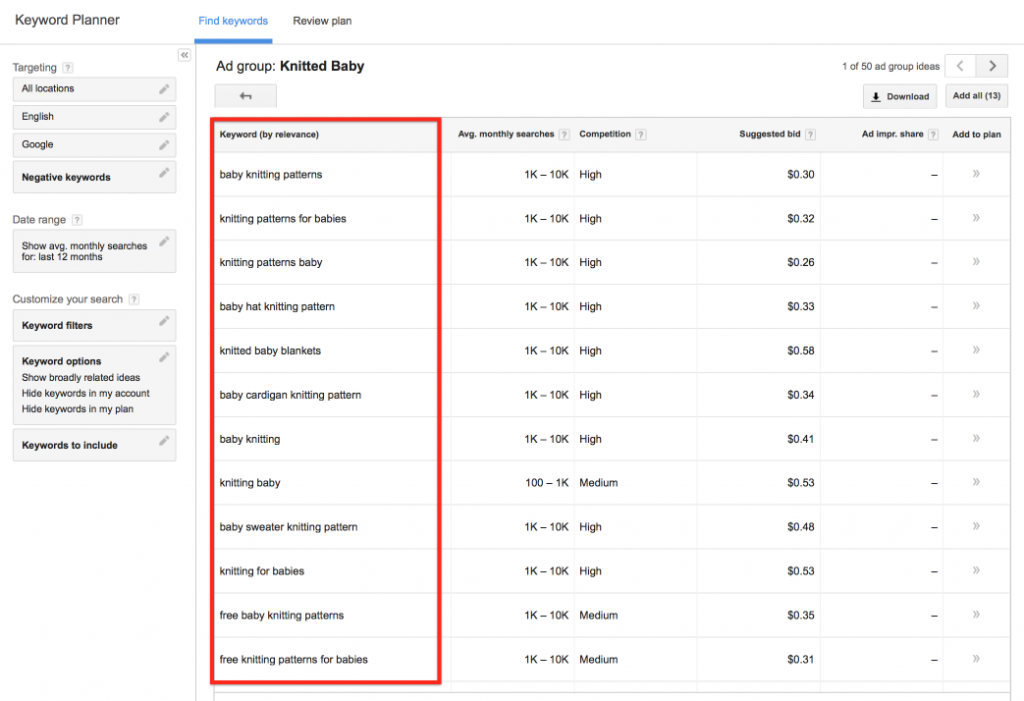
All of these keywords are relatively ‘high volume’ and high-value.
This is shown by the ‘Competition’ levels as well as the ‘Suggested bids’ that are being displayed.
So what should you do from this point?
There are two angles that you can adopt here.
The first, is to treat each of the keywords within the Ad Groups, as potential opportunities that you can tackle. What you could do is create a piece of content for each keyword.
However, this could potentially put you in a position where you’re creating a lot of overlapping content.
As a result, you might alternatively want to tackle each Ad Group as one single opportunity/keyword that you’re going to tackle.
So for the Ad Group of ‘Knitted Baby’ you could create a piece of long form, in depth, content that revolves around the key focus of the ad group – knitting items for babies.
You could then use all of the keywords provided by the Ad Group, as potential topics you need to cover within the post.
By creating a comprehensive, in depth piece of content, using the above approach, it could potentially be easier to attract a lot of links.
It might also make it easier to drive a lot of long tail traffic as people will be searching for keywords related to what can be found in the Ad Group.
On-page SEO for Ecommerce Product Pages
When talking about On Page SEO, a reference is generally being made to the small technical details you’ll want to keep in mind, of which will help increase the odds that your site will rank highly.
This section also relates heavily to product pages, so whatever we’re going to cover here, should be applied also to those pages too – unless stated otherwise.
The first thing we’ll want to focus on is writing precise titles, meta descriptions and sub headings.
More specifically, you need to make sure you’re including your target keyword, within the title of your page.
Aside from letting Google know what your page/content is about, using the right keywords within your title, can help make your site seem more relevant.
If your site accurately represents the keyword that someone has just typed into google, they’ll be more likely to click on your site within the search listings.
This can, therefore, improve the CTR of your site within the search listings, which can also help improve your rankings over time.
This is provided that you use the keyword within the title tag and create an even better piece of content.
Let’s take a look at an example of a website that makes good use of the title tag.
Here’s the title tag of a webpage on the website of Asos, a fashion retailer.

If we look at the result as it appears within Google, we can see that it’s the same.

It’s clear therefore, the title tag will affect what people will see when they’re browsing Google. If your title tag can accurately represent what people are looking to buy, then you increase the odds of them clicking on your search listing and buying from you.
You need to make sure that you’re writing your meta descriptions so that you include your target keyword.
Again, this will produce similar benefits to what we’ve just covered in relation to the title.
When you write your product descriptions well, Google will actually help you out by including a lot of relevant information, within the meta descriptions that are shown within the Google Search results.
It can also help to make use of something known as ‘schema.’
Making use of ‘schema’, also known as scheme markups, will help make it so that Google displays ‘rich snippets’ when showing your results within the search listings.
Here’s an example:

Here’s an example of actual ‘product schema code’ and how it translates into providing information about your product, of which the search engines can use to create ‘rich snippets.’
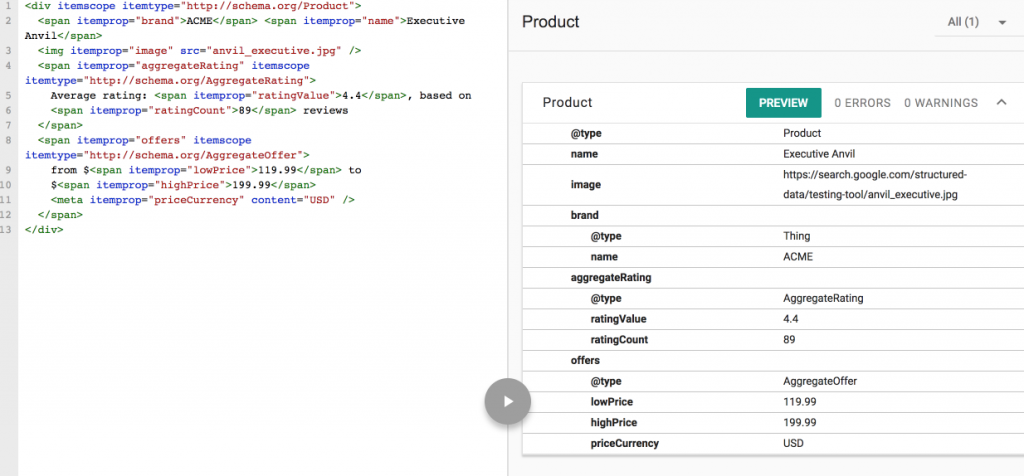
So how do you get this done?
Well, all you need to do is create some code which details the various specifics relating to your product and then insert that code, into the code of the relevant product page.
Luckily, you can get some help with this, by using the ‘Structured Data Markup Helper’ that is provided by Google.
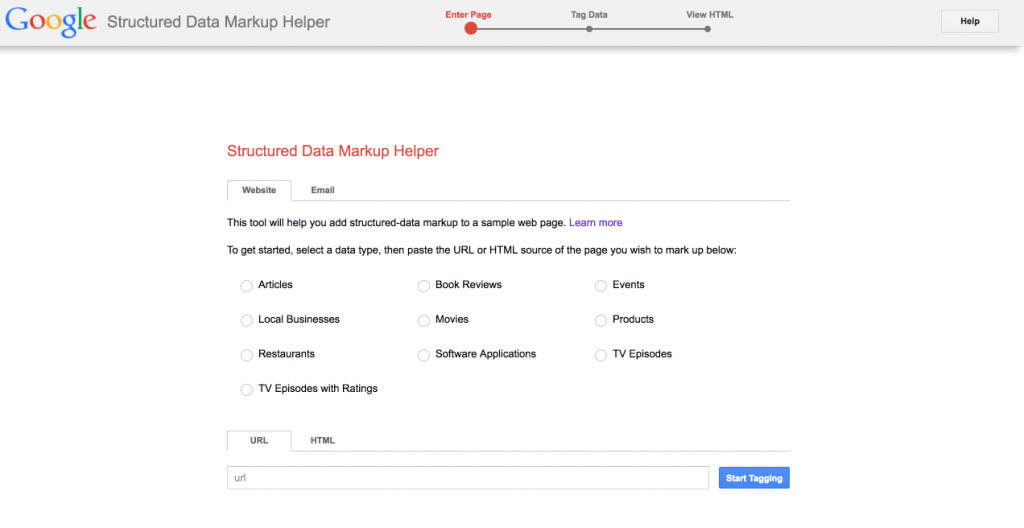
Once you go through the process of using this tool, you be presented with some code that you can insert into your website, of which will ensure that you can benefit from ‘Rich snippets.’
Remember, if you don’t find yourself to be much of an expert, when it comes to website code, you can always work with a freelancer, to get the job done.
It’s also important that you make use of H2 sub headers within your content, and that you use relevant keywords within such headers.
Google’s algorithms will scan the sub headers of your content, to get a better idea of what it is about. You should, therefore, include relevant keywords within your sub headers, in order to improve the odds that Google will deem your content relevant.
If you’re producing a long form piece of content, you can just treat each section as if it were its own blog post.
This means that you use the relevant keywords suggested by the Google Keyword planner within the H2 Header, for the relevant sections. Especially the keywords provided by the Ad Groups tab, in relation to a certain topic.
You’ll also want to focus on writing extensive product descriptions.
By making your product descriptions over 500 words you’ll help improve the odds of your product pages ranking for certain terms.
Of course when you do this, avoid padding out your product descriptions with unnecessary verbiage, as this can actually hurt your rankings, rather than help them.
Whilst it could do with a bit more ‘bolding,’ below is a great example of a product description from a snowboard store.

As you can see, it covers a lot of detail when discussing the product, and doesn’t shy away from providing specific, nitty gritty information.
Providing this level of detail is appreciated by both potential customers, of whom want to know as much as possible about a product before buying – and search engines that want to display relevant results.
You should also pay close attention to site architecture.
You want to set things up so that your homepage, is never more than 3 three clicks away, from any other page on your site.
For most Ecommerce sites, it tends to be the case that the homepage is the most authoritative page on the entire site.
That’s because the more ‘clicks’ a page is away from the homepage, the less authoritative it will be deemed by Google.
As a result, it will benefit less from the authority that Google has given the homepage – authority of which can spread to other pages, if they’re not too many clicks away.
You should also pay close attention to how you name your images.
As you might’ve guessed, it helps to use the relevant keywords when naming your images. Google uses lots of factors to determine how relevant a page is – in relation to specific keyword.
By giving your images ‘keyword-rich’ names, you improve the odds of Google recognizing your site as relevant.
Conclusion
In this guide we’ve taken an in depth look at what it takes to use SEO as a means of driving traffic to an Ecommerce store, in the hopes of boosting revenue.
If you’re new to SEO, you might need to read this guide again, so that you can fully appreciate everything that has been covered.
In any case, be prepared to adopt a long term mindset, when it comes to Ecommerce SEO.
While quick tricks might work in helping you boost your rankings in the short term – in the long term such tricks almost always results in a lot of wasted effort and time.
Google will punish you for being sneaky.
But if you stick to the overall strategy we’ve covered in this guide, and adopt the approach we discussed when it comes to finding the right keywords, you’ll be setting yourself up for long term success.
Yes, Ecommerce SEO can be hard work – and it can take a lot of time before you start to see results.
Though if you start now, in 6-12 months , you’ll be grateful that you took action when you did.
Best of luck!


